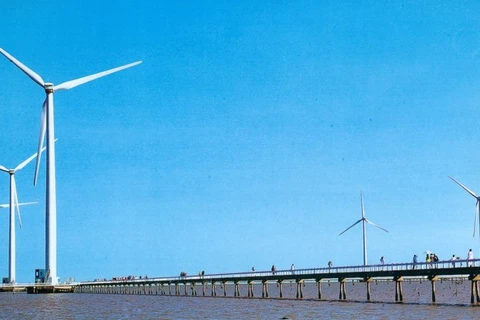HCM City (VNS/VNA) - Vietnam is not expected to meet its target of generating 800 MW of wind power by 2020 as a proposal to increase the regulated selling price of wind power has been postponed.
Bui Van Thinh, Chairman of the Binh Thuan Wind Power Association, said the Ministry of Industry and Trade had sent a proposal to raise the regulated selling price of wind power to the Government, but the decision, expected at the end of last year or beginning of this year, would be delayed.
Last year, the association asked the Ministry of Industry and Trade to raise the selling price of wind power to 9.5-10 US cents per kWh, up from 7.8 cents.
Vietnam has great potential for wind power, estimated at about 10,000 MW, according to research by the German International Cooperation Agency (GIZ).
Initially, the Government set a target of generating 1,000 MW of wind power by 2020, but later lowered it to 800 MW.
Only four wind power projects are operating in the country with a total capacity of 160 MW.
Meanwhile, total capacity of the proposed registered wind power projects has reached 5,700 MW.
Most of the investors postponed the projects because regulated prices were below production costs, Thinh said.
For example, Ben Tre province licensed five wind-power projects with a total capacity of 150 MW, but investors have been waiting for the price to increase.
Nineteen wind power projects were registered in the south-central province of Binh Thuan, but work on them has yet to begin, he said.
The regulated selling price of wind power in Vietnam is among the lowest in the world, only 7.8 cents per kWh (compared to Thailand with 20 cents per kWh, the Philippines with 29 cents per kWh, and Japan with 30 cents per kWh).
In addition, poor infrastructure such as seaports and roads are also a challenge for investors.
Thinh said, however, that the wind power market was still attractive to foreign investors.
Thinh, who is also director of the Thuan Binh Wind Power Joint-Stock Company, said the company was upbeat about renewable energy as the industry was expected to flourish when the price increased.
After operating the first phase of the Phu Lac Wind Power plant with a capacity of 24 MW in Binh Thuan province, the company now plans to increase the charter capital from 240 billion VND (10.54 million USD) to 450 billion VND (19.76 million USD) to develop new projects with an estimated total capacity of 510 MW of wind power and more than 570 MW of solar power.
“From now to 2030, we need more than 2 billion USD to develop wind power and solar power projects in Binh Thuan and Ninh Thuan provinces and the Central Highlands region,” Thinh said.
Moreover, to increase revenue for the company, the Phu Lac Wind Power Plant plans to develop wind power and solar power in combination with eco-tourism, Thinh said.
The number of wind power projects in Vietnam remains low since only wind turbine towers, which account for 20 percent of production costs, can be produced locally, while investors have to import the other components.
Vietnam plans to produce propellers valued at 10 percent of the investment cost, turbines worth 7 percent of the cost, and several other small components.
A Republic of Korea firm in Ba Ria-Vung Tau province produces wind turbine towers, and a US company manufactures turbines in the northern port city of Hai Phong.
“If the wind power market achieves strong growth in the future and attracts foreign investors capable of producing complicated parts, we will be able to raise the localisation ratio to more than 40 percent,” Thinh said.
Vietnam needs to switch to renewable energy such as wind and solar power as the country has cancelled its first two nuclear power projects and has started implementing commitments on reducing greenhouse gas emissions, experts have said.
The country’s total wind power output has reached only 160MW, far below the huge potential that exists in the country.
The Government has released its National Electricity Development Plan for the 2011-2020 period with a strategic priority on renewable energy, with wind power capacity targeted at 800 MW by 2020 and 6,000 MW by 2030.-VNA
Bui Van Thinh, Chairman of the Binh Thuan Wind Power Association, said the Ministry of Industry and Trade had sent a proposal to raise the regulated selling price of wind power to the Government, but the decision, expected at the end of last year or beginning of this year, would be delayed.
Last year, the association asked the Ministry of Industry and Trade to raise the selling price of wind power to 9.5-10 US cents per kWh, up from 7.8 cents.
Vietnam has great potential for wind power, estimated at about 10,000 MW, according to research by the German International Cooperation Agency (GIZ).
Initially, the Government set a target of generating 1,000 MW of wind power by 2020, but later lowered it to 800 MW.
Only four wind power projects are operating in the country with a total capacity of 160 MW.
Meanwhile, total capacity of the proposed registered wind power projects has reached 5,700 MW.
Most of the investors postponed the projects because regulated prices were below production costs, Thinh said.
For example, Ben Tre province licensed five wind-power projects with a total capacity of 150 MW, but investors have been waiting for the price to increase.
Nineteen wind power projects were registered in the south-central province of Binh Thuan, but work on them has yet to begin, he said.
The regulated selling price of wind power in Vietnam is among the lowest in the world, only 7.8 cents per kWh (compared to Thailand with 20 cents per kWh, the Philippines with 29 cents per kWh, and Japan with 30 cents per kWh).
In addition, poor infrastructure such as seaports and roads are also a challenge for investors.
Thinh said, however, that the wind power market was still attractive to foreign investors.
Thinh, who is also director of the Thuan Binh Wind Power Joint-Stock Company, said the company was upbeat about renewable energy as the industry was expected to flourish when the price increased.
After operating the first phase of the Phu Lac Wind Power plant with a capacity of 24 MW in Binh Thuan province, the company now plans to increase the charter capital from 240 billion VND (10.54 million USD) to 450 billion VND (19.76 million USD) to develop new projects with an estimated total capacity of 510 MW of wind power and more than 570 MW of solar power.
“From now to 2030, we need more than 2 billion USD to develop wind power and solar power projects in Binh Thuan and Ninh Thuan provinces and the Central Highlands region,” Thinh said.
Moreover, to increase revenue for the company, the Phu Lac Wind Power Plant plans to develop wind power and solar power in combination with eco-tourism, Thinh said.
The number of wind power projects in Vietnam remains low since only wind turbine towers, which account for 20 percent of production costs, can be produced locally, while investors have to import the other components.
Vietnam plans to produce propellers valued at 10 percent of the investment cost, turbines worth 7 percent of the cost, and several other small components.
A Republic of Korea firm in Ba Ria-Vung Tau province produces wind turbine towers, and a US company manufactures turbines in the northern port city of Hai Phong.
“If the wind power market achieves strong growth in the future and attracts foreign investors capable of producing complicated parts, we will be able to raise the localisation ratio to more than 40 percent,” Thinh said.
Vietnam needs to switch to renewable energy such as wind and solar power as the country has cancelled its first two nuclear power projects and has started implementing commitments on reducing greenhouse gas emissions, experts have said.
The country’s total wind power output has reached only 160MW, far below the huge potential that exists in the country.
The Government has released its National Electricity Development Plan for the 2011-2020 period with a strategic priority on renewable energy, with wind power capacity targeted at 800 MW by 2020 and 6,000 MW by 2030.-VNA
VNA
























